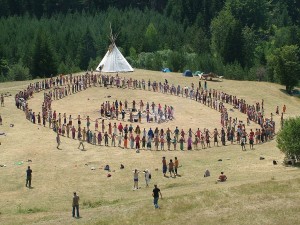Internet Communities & The Rainbow Family
Posted on November 15, 2013 | posted by:
I first heard about the Rainbow Family from a friend who runs in the anarchist-hippie crowd, and took it with a large grain of salt. A bunch of hippies in the woods for a month? There must be lots of drugs and trash. But when I arrived at the 2010 European Gathering outside of Kuopio, Finland, there was only a group of smiling people at the top of a narrow path, saying, “Welcome, sister, welcome home.” There was not a single piece of trash on the ground, and when I came to the end of the path into the main camping area, it looked much more like a well-maintained, chaotic campground than a festival. There were several earthwork buildings, including a kitchen and a meeting space, as well as several people in the midst of building a massive pizza oven (who, I later learned, had never met before embarking on the project).
I stayed for two weeks in the woods, never left the site, and was well fed, watered and entertained by the huge diversity of people I found there. There was no leader, no organizing force except for the needs of the people who, for those weeks, made it their home.
Well, and one rule:
If you see a job, it’s yours.
This rule, & its inherent exhortation to contribute whatever you have to the community, results in a surprisingly well-organized and supplied “town”, where people who have money to give give it, people who have knowledge to share share it, and people who have effort and energy to expend spend it. Cooks cook for everyone, musicians make music for the cooks, people with a few extra hours of free time dig “shit pits”, the outdoor latrines used by the entire gathering, and people who know how to dance or throat-sing or teach laughing yoga share their skills with others in self-organized and publicized workshops.
Creating online social structures is the new frontier in community, with many divergent opinions on how best to create responsible collectives. Slashdot is one such community, where a few rules of engagement have succeeded (to a greater or lesser extent) in sustaining a meaningful conversation amongst a whole lot of noise. Other–real-life–communities like this abound, though, often stemming from anarchist principles and based on similarly simple rule sets.
One of the most successful and long-lived alternative communities like this is the Rainbow Family of the Living Light. Despite its rather new-age name, it works in a similar way to online forums, where disparate people (without previous connections or reasons for interacting) assemble in a space outside of their immediate surroundings and create a community around a shared set of interests or ideals. Much like Burning Man (its more popular and mainstream sibling), a Gathering employs the resources and skills of the people who participate to do the work of the community as a whole, as well as getting the needs of each individual member met. It has its share of troubles, but that doesn’t mean it doesn’t continue to exist and provide a space for expression for the people who participate in it.
In our search for cultivating social responsibility on the internet, there are many examples to turn to for insight about the way that people gather, create new content and sustain interactions. Alternative communities provide a rich source of experience and knowledge, and the Rainbow Family is a particularly successful demonstration of emergent principles at work in a social environment.
